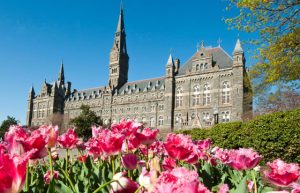Georgetown undergraduates are facing another annual tuition increase, 3.5 percent for the upcoming academic year, according to a Feb. 14 announcement from the Provost.
Georgetown’s tuition for the ongoing 2021-22 academic year before aid stood at $59,784, a 4 percent increase from the year prior. This percentage mirrors that of previous years: a 3.51 percent increase for 2020-21, and a 3.59 percent increase the year before that, accounting for inflation.
Across the board, concerns surrounding the affordability of higher education are not novel. Over the past three decades, college tuition has more than doubled: at private institutions, the average cost of an undergraduate degree rose from $16,590 in 1990 to $34,059 in 2020.
These concerns have been further exacerbated in the age of COVID-19. In January 2022, when classes started virtually and many facilities on campus were partially or fully closed, more than 200 Georgetown students petitioned for a tuition and housing refund for the spring 2022 semester. While the university reinstated most normal operations on Feb. 12 to return to fully-masked classes and events, the administration has not addressed the refund demands.
Rising costs create looming financial burdens. On the topic of student debt, one graduating Georgetown senior expressed, “I’m planning on delaying all major purchases for the next five to six years, and I’m expecting all of my excess earnings to go towards paying off student debt for the next seven to eight years.”
Student loan servicers rely on rising tuition and student loan accessibility. A recent alumnus told the Voice: “Student loan is the easiest type of loan to take out, yet one of the most difficult to navigate. Students are undereducated on [this topic].”
Despite annual increases in higher education budgets, a national average of only 48 percent of the costs go to educational purposes, such as faculty salaries. According to the Feb. 14 email from the Provost, instruction accounts for 30 percent of undergraduate expenses. Universities across the U.S., in an effort to offset expenses, have begun to give less of the teaching body tenure and hire more adjunct professors and teaching assistants. Adjunct faculty account for about 1,000 positions at Georgetown. While they take on prominent responsibilities in supporting the student body, they receive insufficient compensation and lack the benefits available to tenured colleagues.
Conversely, while the average adjunct salary has decreased by 49 percent over the past four decades, college presidents’ salaries went up by 35 percent, and the number of administrators at private universities increased by 135 percent. These include provosts, presidents, chancellors, and other high-level positions. The number of high-level administrators making over one million dollars per year increased from 28 in 2009 to 76 in 2017. In short, the payroll of higher positions occupy a good portion of the remaining fraction of student expenses.
Yet, the primary beneficiaries of rising costs are university endowment managers, who receive more pay than anybody on campus. In 2014, Yale spent $400 million on investment managers–three times what the university spent on tuition assistance. This is the case with most universities, who utilize endowment funds for hedge funds, real estate, stocks and bonds; only 5 percent of university endowments are actually mobilized for usage, and frequently, little to no endowment is used for financial aid purposes.
After two grueling years of virtual and hybrid classes, the value of college attendance has come under scrutiny. On the one hand, there are intangible benefits to being on a college campus. Students, some of whom are the first in their family to attend university, establish networks, engage in different disciplines, and cultivate their critical thinking in academic settings. Over the course of their careers, those with a college degree earn significantly more than their non-college educated counterparts. For low-income students, a college education can act as an engine for social mobility by offering a 90 percent chance of escaping poverty. On the other hand, these disparities simultaneously dim the quality of life without such degree credentialing.
According to a university spokesperson, “Beginning in fall of 2019, the university embarked on a strategy to eliminate fees charged in addition to tuition, such as the fee for Yates Field House fee. In fall 2020, we also eliminated separate fees for science and language laboratories and course material fees.” In addition, the Feb. 14 email read, “In academic year 2022-23, Georgetown plans to make its largest investment in financial aid in the history of the university, with an estimated $137 million dollars set aside for all new and continuing undergraduate students across our campuses.”
While there are some efforts to boost financial aid, rising tuition outpaces the increase in grants and scholarships. Many college students turn to student loans to offset the immediate financial burden. Today, over 44 million American students are loan borrowers, and the average student debt sits at $30,000. In 2020, the total student debt had accumulated to a staggering $1.5 trillion, towering both credit card debt and auto loan debt. Further, student borrowers are seldom equipped with the proper tools and resources to navigate their student loans and payoff plans post-graduation, and are often subject to misguidance from government-contracted loan servicers.
In a loan-fueled higher education structure, finances have in some cases become a taboo topic. “I have some friends who expressed that they wouldn’t want to spend any money after taking a look at their compound interest, which is very unrealistic,” an alumnus said, “and others who don’t want to talk about student debt at all because it stresses them out so much.”





